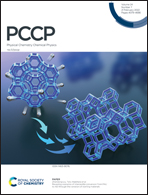Full-dimensional Schrödinger wavefunction calculations using tensors and quantum computers: the Cartesian component-separated approach
Abstract
Traditional methods in quantum chemistry rely on Hartree–Fock-based Slater-determinant (SD) representations, whose underlying zeroth-order picture assumes separability by particle. Here, we explore a radically different approach, based on separability by Cartesian component, rather than by particle [J. Jerke and B. Poirier, J. Chem. Phys., 2018, 148, 104101]. The approach appears to be very well suited for 3D grid-based methods in quantum chemistry, and thereby also for so-called “first-quantized” quantum computing. We first present an overview of the approach as implemented on classical computers, including numerical results that justify performance claims. In particular, we perform numerical calculations with four explicit electrons that are equivalent to full-CI matrix diagonalization with nearly 1015 SDs. We then present an implementation for quantum computers for which the number of quantum gates (and to a lesser extent, the number of qubits) can be dramatically reduced, in comparison with other quantum circuitry that has been envisioned for implementing first-quantized “quantum computational chemistry” (QCC).

- This article is part of the themed collections: Quantum computing and quantum information storage: Celebrating the 2022 Nobel Prize in Physics and Quantum Computing and Quantum Information Storage


 Please wait while we load your content...
Please wait while we load your content...